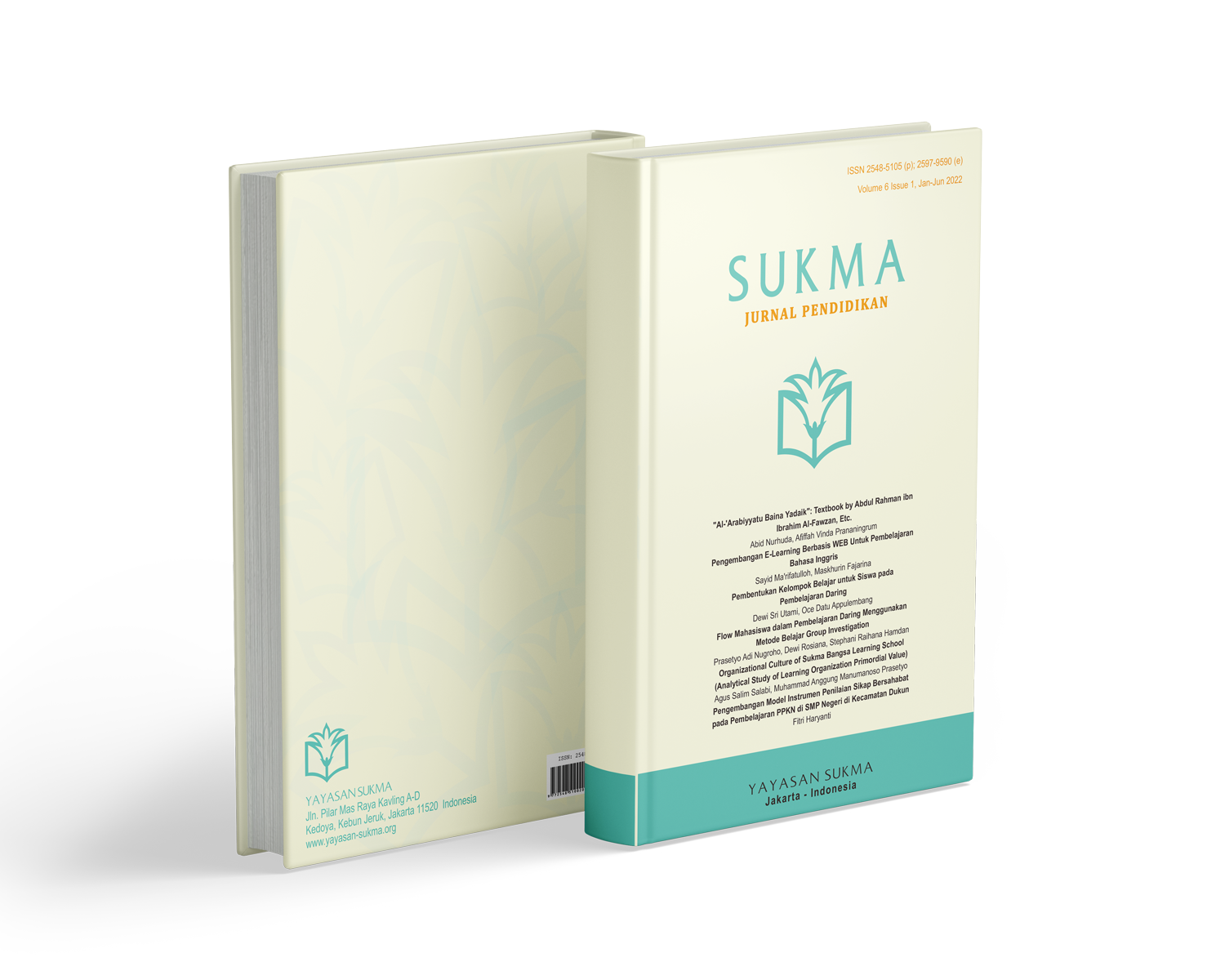Flow Mahasiswa dalam Pembelajaran Daring Menggunakan Metode Belajar Group Investigation
DOI:
https://doi.org/10.32533/06104.2022Keywords:
Flow, Online Learning, University, Group Investigation MethodAbstract
Online learning during the Covid-19 pandemic is an alternative solution to keep the learning process running, including in universities. This study aims to find out what learning methods with group investigation (GI) methods are, which can improve the quality of the online learning experience and generate flow. This study uses a quantitative approach with an experimental design, namely between participant posttest only control group design. This study compares the effect of using two variants of the Group Investigation method on the flow experience felt by students when learning online. Participants in this study amounted to 27 people (96.3% women). The mean age of the participants was 21.4 years with a standard deviation of 1.12. The results showed that the use of two variants of the Group Investigation method gave the effect of flow with values that tended to be the same. The implication is that the two variants of the Group Investigation method can be used in online learning because they significantly produce student flow experiences in online learning.Pembelajaran daring selama Pandemi Covid-19 menjadi alternatif solusi yang dilakukan agar proses pembelajaran tetap berjalan, termasuk di perguruan tinggi. Penelitian ini bertujuan untuk mengetahui metode pembelajaran dengan metode group investigation (GI) seperti apa, yang dapat meningkatkan kualitas pengalaman belajar daring dan menghasilkan flow. Penelitian ini menggunakan pendekatan kuantitatif dengan desain eksperimental, yaitu between participant posttest only control group design. Penelitian ini membandingkan pengaruh penggunaan dua varian metode Group Investigation terhadap pengalaman flow yang dirasakan mahasiswa saat pembelajaran daring. Partisipan pada penelitian ini berjumlah 27 orang (96, 3 % perempuan). Rerata usia partisipan yaitu 21,4 tahun dengan standar deviasi sebesar 1,12. Hasil penelitian menunjukkan penggunaan dua varian metode Group Investigation memberikan pengaruh flow dengan nilai yang cenderung sama besarnya. Implikasinya, kedua varian metode Group Investigation dapat digunakan dalam pembelajaran daring karena secara signifikan menghasilkan pengalaman flow mahasiswa dalam pembelajaran daring.ÂReferences
Christensen, Larry B, R Burke Johnson, and Lisa A Turner. 2015. Design , and Analysis Twelfth Edition.
Csikszentmihalyi, Mihaly. 1997. Finding Flow: The Psychology of Engagement with Everyday Life. Hachette UK.
Herminingsih, H. 2021. “Pembelajaran Daring Pada Masa Pandemi Covid-19 Melalui Aplikasi Teams Meeting.†Sukma 5 (1): 63–78.
“Indonesia Bicara: ‘Indonesia Belajar Dari Rumah: Daring Hingga Luring.’†2020. Indonesia. 2020. https://www.youtube.com/watch?v=KbROBdJSv74&t=2156s.
Johnson, David W, and Roger T Johnson. 2011. “Cooperative Learning.†The Encyclopedia of Peace Psychology., 11.
Johnson, Lisa S. 2008. “Relationship of Instructional Methods to Student Engagement in Two Public High Schools.†American Secondary Education 36 (2): 69–87. http://ezp.waldenulibrary.org/login?url=http://search.ebscohost.com/login.aspx?direct=true&db=eric&AN=EJ809470&site=ehost-live&scope=site&scope=cite.
“Keputusan Bersama Mendikbud, Menag, Menkes, Dan Mendagri RI.†2020. 2020. https://www.kemdikbud.go.id/main/files/download/5baf1873d5766d3.
Larson, Susan Cosenza. 2011. “The Effect of Academic Literacy Instruction on Engagement and Conceptual Understanding of Biology of Ninth-Grade Student.â€
Naseh, Ahmad Hanany, and Nurul Khofifah. 2021. “Peran Guru Akidah Akhlak Dalam Membentuk Akhlakul Karimah Siswa Kelas Viii Mts N 7 Bantul Di Masa Pandemi Covid-19†5 (2): 121. https://digilib.uin-suka.ac.id/id/eprint/44547/.
Parker, Jeffrey G, Steven R Asher, Jeffrey G Parker, and Steven R Asher. 1987. “Peer Relations and Later Personal Adjustment : Are Low-Accepted Children At Risk ? Peer Relations and Later Personal Adjustment : Are Low-Accepted Children At Risk ?,†no. December. https://doi.org/10.1037/0033-2909.102.3.357.
Rathunde, Kevin, and Mihaly Csikszentmihalyi. 2005. “Middle School Students’ Motivation and Quality of Experience: A Comparison of Montessori and Traditional School Environments.†American Journal of Education 111 (3): 341–71. https://doi.org/10.1086/428885.
RodrÃguez-Ardura, Inma, and Antoni Meseguer-Artola. 2017. “Flow in E-Learning: What Drives It and Why It Matters.†British Journal of Educational Technology 48 (4): 899–915. https://doi.org/10.1111/bjet.12480.
Sharan, Yael, and Shlomo Sharan. 1992. Expanding Cooperative Learning Through Group Investigation. New York: Teachers College Press.
———. 1994. Handbook of Cooperative Learning Method. Edited by Shlomo Sharan. Wesport: Greenwood Press.
Shernoff, David J., Anderson, Brett. 2014. “Enacting Flow and Student Engagement in the College Classroom.†In The Wiley Blackwell Handbook of Positive Psychological Interventions, 194. John Wiley & Sons, Ltd.
Shernoff, David J. 2013. Optimal Learning Environments to Promote Student Engagement. https://doi.org/10.1007/978-1-4614-7089-2.
Slavin, R. E. 2012. Educational Psychology: Theory and Practice. 10th ed. Boston: Pearson Education, Inc.
Wigfield, Allan, and Jacquelynne S. Eccles. 2000. “Expectancy-Value Theory of Achievement Motivation.†Contemporary Educational Psychology 25 (1): 68–81. https://doi.org/10.1006/ceps.1999.1015.
Zingaro, Daniel. 2008. “Group Investigation: Theory and Practice.†Ontario Institute for Studies in Education, Toronto, Ontario. Juli 2008: 1–8. www.danielzingaro.com/gi.pdf.
Downloads
Published
How to Cite
Issue
Section
License
Authors who publish with this journal agree to the following terms:- Authors retain copyright and grant the journal right of first publication with the work simultaneously licensed under a Creative Commons Attribution License that allows others to share the work with an acknowledgement of the work's authorship and initial publication in this journal.
- Authors are able to enter into separate, additional contractual arrangements for the non-exclusive distribution of the journal's published version of the work (e.g., post it to an institutional repository or publish it in a book), with an acknowledgement of its initial publication in this journal.
- Authors are permitted and encouraged to post their work online (e.g., in institutional repositories or on their website) prior to and during the submission process, as it can lead to productive exchanges, as well as earlier and greater citation of published work (See The Effect of Open Access).















